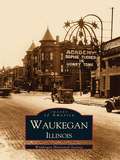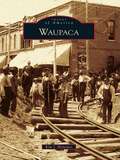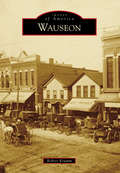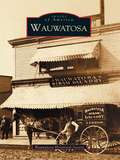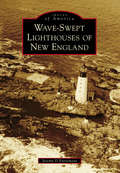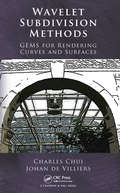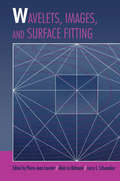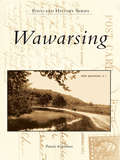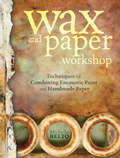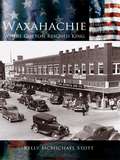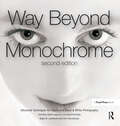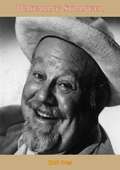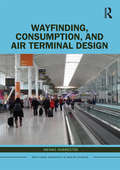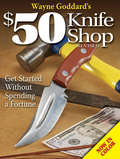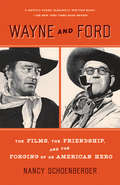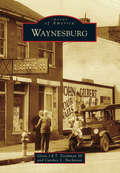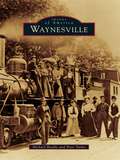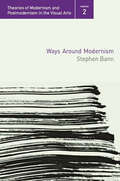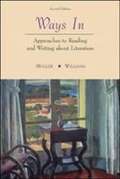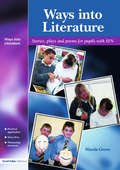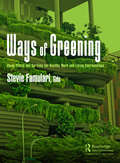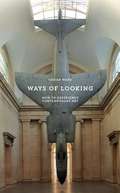- Table View
- List View
Waukegan, Illinois
by Waukegan Historical SocietyWaukegan, Illinois has a long history, with a rich and varied heritage. Countless individuals, businesses, and organizations have contributed to that heritage, and continue today to contribute to the legacy of this community. One of Waukegan's most notable citizens was Jack Benny. Throughout his long career he regularly cited his hometown and its influence on him, and he often contributed to the city with his many appearances. But he wasn't the only person to bring fame to Waukegan. Edward Amet's motion picture projector and Johnson's outboard motors made Waukegan memorable in the minds of millions. And Louise Dekoven Bowen's generosity is a source of pride to its residents.
Waupaca
by Kim J. HeltemesIn 1849, the Native American lands of central Wisconsin were opened, by way of treaty, for land claims by settlers. The area of eastcentral Wisconsin was a favorite to men from Vermont. Vermont men had settled the wild country from Poy Sippi to Waupaca--a stretch of about 15 miles. That year, the county's earliest pioneers set out from Sheboygan to stake a claim for their homesteads. Told of a place called "the Falls," now known as Waupaca, they mapped out three 80-acre plots after their arrival. As more settlers came to the area, Waupaca was formed into a village and incorporated in 1857. The accumulation of vintage photographs that appear in Waupaca depict the town's old way of life in a vivid manner.
Wauseon
by Robert KrummFounded in 1852 amid dense forests and the mosquito-infested Great Black Swamp, Wauseon became the county seat of one of the last areas in Ohio to be settled. Named in honor of a local Potawatomi chief, Wauseon is the birthplace of Ohio's last surviving Civil War veteran and early race car legend Barney Oldfield. Wauseon was one of the first communities in the United States to implement rural mail delivery and establish a public phone service. Among its manufacturing operations is a company that made flashlights used on the Apollo moon landings. Wauseon is truly a city people take to heart, reflecting strong Midwestern values.
Wauwatosa
by Wauwatosa Historical SocietyFirst called Hart's Mills, after its founder Charles Hart who settled here in 1835, early Wauwatosa resembled a New England village, complete with a commons. Its first pioneers were Yankees and New Yorkers, later joined by Germans who would mold the growing community. Wauwatosa became the most highly developed, unincorporated settlement in Milwaukee County. It attained a degree of sophistication with its commercial mix of mills, a pickle factory, inns, modest businesses, and nearby stone quarries and breweries. Vital links to Milwaukee in 1851, the Watertown Plank Road and the state's first railroad through the village center to Waukesha, enhanced this development. In 1852, the County Board selected a site nearby for its poor farm. Wauwatosa incorporated as a village in 1892, attaining city status in 1897. The streetcar of the 1890s and the automobile fueled residential growth. Wauwatosa became known as the "City of Homes." In the 1950s, Wauwatosa tripled in size with final annexations and was transformed into a major center of commercial and industrial development, while retaining large public green spaces, parkways, and recreational sites.
Wave-Swept Lighthouses of New England (Images of America)
by Jeremy D’EntremontThe lighthouse is a pervasive icon in our culture, often used to symbolize positive qualities like faith, guidance, strength, and steadfastness. No structures embody these qualities more than wave-swept lighthouses, which were built to withstand the most extreme forces of wind and ocean waves, often in isolated, rocky locations far offshore. In the United States, the earliest attempts to build wave-swept lighthouses in the 1830s led to several masterpieces of engineering, a few of which are in the New England region. This book primarily focuses on six such structures: Whaleback (Maine), Saddleback Ledge (Maine), Minot's Ledge (Massachusetts), Halfway Rock (Maine), Graves Ledge (Massachusetts), and Ram Island Ledge (Maine). All of these wave-swept lighthouses stand in rugged testimony to the people who designed and built them, and they also serve to remind us of the struggles and sacrifices of the lighthouse keepers who "kept a good light" for so many years before automation.
Wavefront Shaping and Pupil Engineering (Springer Series in Optical Sciences #235)
by Jorge Ojeda-CastañedaThis book presents a simple, yet comprehensive, treatment of the basic principles and applications of novel phase masks and non-uniform optical windows under the increasingly popular umbrella term “pupil engineering.” It discusses current research topics in the areas of phase-space representations for engineering imaging devices with extended depth of field, as well as sparse optical sensing and emergent phenomena such as vortices and singularities, highlighting the heuristic applications of key concepts in novel models and their graphic representations. The book is appealing to anyone interested in robotic vision and is a valuable resource for upper-level students, teachers, scientists, and engineers in the field of image science, lasers, and digital image processing.
Wavelet Subdivision Methods: GEMS for Rendering Curves and Surfaces
by Charles Chui Johan De VilliersPrevalent in animation movies and interactive games, subdivision methods allow users to design and implement simple but efficient schemes for rendering curves and surfaces. Adding to the current subdivision toolbox, Wavelet Subdivision Methods: GEMS for Rendering Curves and Surfaces introduces geometry editing and manipulation schemes (GEMS) and co
Wavelets, Images, and Surface Fitting
by Larry L. Schumaker Pierre-Jean Laurent Alain Le MéhautéThis volume documents the results and presentations relating to the use of wavelet theory and other methods in surface fitting and image reconstruction of the Second International Conference on Curves and Surfaces, held in Chamonix in 1993. The papers represent directions for future research and development in many areas of application.
Wawarsing (Postcard History Series)
by Pamela KuhlmannEstablished in 1806, the town of Wawarsing is located in the beautiful Shawangunk Mountains in Ulster County. The town is comprised of many small hamlets, as well as the village of Ellenville. The abundance of mountain streams provided electricity to run factories, and in the early 1900s, these communities were flourishing. The Delaware and Hudson Canal opened in 1828 and provided a venue for factories to transport goods. Following the close of the canal in 1898, the Ontario and Western Railroad took over, shuttling summer vacationers from New York City. The vintage postcards in Wawarsing provide views of the Delaware and Hudson Canal, the Ontario and Western Railroad, and a glimpse back to a quieter time when the mountain and valley landscape provided picturesque locations for lovely hotels and boardinghouses.
Wax and Paper Workshop: Techniques for Combining Encaustic Paint and Handmade Paper
by Michelle BeltoWax + Paper = Artistic Bliss! Unconventional? Sure. The next wave in encaustic painting? Absolutely! Encaustic artists have been branching out--trying new techniques and mediums, mixing it up with unique textures and using traditional art supplies in wholly unexpected ways. So why shouldn't the surfaces be evolving as well? Well, now they are! In Wax and Paper Workshop, not only will you learn some crazy cool techniques (like working with rust and tar and learning how to emboss and embed), you will also explore the benefits of working on paper surfaces--both commercially made and your own handmade papers! Inside you'll find: All the basics for working in both wax and paper, including a thorough explanation of required materials and suggestions for setting up your workspace. Easy to understand instructions for making paper and supports to suit your every need and whim. 14 completely stepped-out encaustic techniques, including those for working on the wax and in the wax for adding tone and nuance to your encaustic masterpieces. Dozens of author studio samples and gallery pieces to illustrate, delight and inspire. A contributors gallery highlighting the best and the brightest working in wax and paper and giving a sneak peek of the future of these two dynamic and complementary mediums. You'll find something new and exciting on every page--add Wax and Paper Workshop to your creative toolbox and expand your artistic horizons today!
Waxahachie: Where Cotton Reigned King
by Kelly Mcmichael StottThe people of Waxahachie, Texas, have always been at the heart of a thriving community that was once the largest cotton-producing county in the nation. As county seat, Waxahachie burgeoned into a bustling center for business and education and carved out a unique niche in the growing landscape. But its citizens overcame significant obstacles as well, facing such challenges as a massive slave revolt during the Civil War and the economic bust of the 1930s. Reflecting both the glory and hardship of these struggles, Waxahachie today stands as a testament to Southern determination and how a town came to be defined by a crop on which America still relies-cotton.Always with an eye on their future, the people of Waxahachie, in 1912, supported the development of an interurban electric railway system linking them to Dallas and Waco. Each July between 1900 and 1930, Texans from all over the state came to Waxahachie by covered wagon, on horseback, and later by automobile to participate in the national Chautauqua phenomenon and hear such great orators as William Jennings Bryan and Will Rogers. Waxahachie's Chautauqua Auditorium, still in use today, is one of the few national survivors of this educational movement. This tradition of community and culture survives to the present day in such events as the Scarborough Fair, the National Polka Festival, and the Gingerbread Trail of Homes. In this new historical account, Waxahachie, Texas: Where Cotton Reigned King, the town springs to life in a blend of more than 100 vintage photographs and stories that chronicle the perseverance and love of a people for their town.
Way Beyond Monochrome 2e: Advanced Techniques for Traditional Black & White Photography including digital negatives and hybrid printing
by Chris Woodhouse Ralph LambrechtAn inspirational bible for monochrome photography - this second edition almost doubles the content of its predecessor showing you the path from visualization to print
Wayfaring Stranger (American Autobiography Ser.)
by Burl IvesFirst published in 1948, this autobiography from Burl Ives, whom Carl Sandberg calls “the greatest folk ballad singer of them all,” is as fresh and wholesome as a summer’s breeze out of an Illinois cornfield. His ballads have long been an authentic expression of his land and its people—songs his grandmother taught him in the Midwestern farm country, songs remembered by old-timers in small towns all over the land, songs he heard hobos singing—songs we have come to know and love.In Wayfaring Stranger, writing in the stirring imaginative language of the ballad, Burt Ives tells of a night spent in a haystack with a pig, and of a brief fight with a railroad cop on top of a boxcar. He hitched a ride with Al Capone’s master bootlegger; he barely escaped the clutches of an old maid in Maine; he fell in love on a Great Lakes steamer; he played for evangelists and politicians; in speakeasies and public parks. Always he listened to the people, and he learned their songs. Anywhere he could get an audience, he sang his ballads: Barbara Allen, The Riddle Song, Fair Eleanor, Old Smokey, Silver Dagger, Foggy Foggy Dew.Now in Wayfaring Stranger, he has written his own story—as warm and appealing as the songs he sings.“It’s a fine book, warm, and full-bided, like Burl himself. Burl gives the reader the combination which is in everything he sings: a sense of dignity without pretentiousness, of simplicity without sentimentality. He makes the folk feeling richly alive. Some of his little character sketches remind me of the unforgettable etchings in Sherwood Anderson’s Winesburg. In short, Burl tells stories just the way he plays and sings—naturally, unaffectedly, poignantly.”—Louis Untermeyer
Wayfinding, Consumption, and Air Terminal Design (Routledge Research in Design Studies)
by Menno HubregtseThis book investigates how international air terminals organize passenger movement and generate spending. It offers a new understanding of how their architecture and artworks operate visually to guide people through the space and affect their behaviour. Menno Hubregtse’s research draws upon numerous airport visits and interviews with architects and planners, as well as documents and articles that address these terminals’ development, construction, and renovations. The book establishes the main concerns of architects with respect to wayfinding strategies and analyzes how air terminal architecture, artworks, and interior design contribute to the airport’s operations. The book will be of interest to art historians, architectural historians, practising architects, urban planners, airport specialists, and geographers.
Wayne Fire Department (Images of America)
by Richard L. StoryThe Wayne Fire Department was founded in 1911 as a volunteer fire department with 12 firemen. In 1928, the Village of Wayne purchased its first pumper and started a full-time fire department. The Wayne-Nankin Fire Department was formed in 1942, only to be divided again when the Village of Wayne became the City of Wayne in 1960. In all, this organization has served the community for 94 years. Through rare photographs and detailed historical information, this book documents nearly a century of the Wayne Fire Department's dedicated service.
Wayne Goddard's $50 Knife Shop
by Wayne GoddardDon't spend big bucks on your knife shop! If you've ever dreamed of making knives, Wayne Goddard will show you how to get started without investing a fortune in fancy gear. You'll learn all about selecting steel, forging, grinding, heat treating and finishing knives without the huge and expensive tools found in some shops. Goddard even teaches you to make wire Damascus blades with the simplest of tools. This book is a great companion to Godard's book, The Wonder of Knifemaking, and provides all the details needed to set up a backyard knife shop and start turning out great blades.
Wayne and Ford: The Films, the Friendship, and the Forging of an American Hero
by Nancy SchoenbergerJohn Ford and John Wayne, two titans of classic film, made some of the most enduring movies of all time. The genre they defined—the Western—and the heroic archetype they built still matter today. For more than twenty years John Ford and John Wayne were a blockbuster Hollywood team, turning out many of the finest Western films ever made. Ford, known for his black eye patch and for his hard-drinking, brawling masculinity, was a son of Irish immigrants and was renowned as a director for both his craftsmanship and his brutality. John “Duke” Wayne was a mere stagehand and bit player in “B” Westerns, but he was strapping and handsome, and Ford saw his potential. In 1939 Ford made Wayne a star in Stagecoach, and from there the two men established a close, often turbulent relationship. Their most productive years saw the release of one iconic film after another: Rio Grande, The Quiet Man, The Searchers, She Wore a Yellow Ribbon, The Man Who Shot Liberty Valance. But by 1960 the bond of their friendship had frayed, and Wayne felt he could move beyond his mentor with his first solo project, The Alamo. Few of Wayne’s subsequent films would have the brilliance or the cachet of a John Ford Western, but viewed together the careers of these two men changed moviemaking in ways that endure to this day. Despite the decline of the Western in contemporary cinema, its cultural legacy, particularly the type of hero codified by Ford and Wayne—tough, self-reliant, and unafraid to fight but also honorable, trustworthy, and kind—resonates in everything from Star Wars to today’s superhero franchises. Drawing on previously untapped caches of letters and personal documents, Nancy Schoenberger dramatically narrates a complicated, poignant, and iconic friendship and the lasting legacy of that friendship on American culture.
Waynesburg
by Candice L. Buchanan Glenn J. Toothman IIIWaynesburg was founded in 1796 as the county seat of the newly formed Greene County, Pennsylvania. The state's General Assembly approved its formation after a petition was submitted by the citizens of this southwesternmost corner of the state. The people desired a more convenient location to transact their legal affairs, not wanting to ride the rugged roads north 30 miles to the county and town of Washington. The new county and its capital were named in honor of soldiers who helped General Washington to win the Revolutionary War, Nathaniel Greene and Mad Anthony Wayne, respectively. Waynesburg travels back to the early days of the area's growing years, documenting the evolution of High Street from the time of dirt roads to brick pavers and revisiting the Downey House and its tragic fire, the men of Company K, the Waynesburg Brewery, the Soldiers and Sailors Monument as it was built, the Hookstown Cemetery, the Courthouse Square, the Waynesburg College campus, and other icons of local history.
Waynesville (Images of America)
by Michael Beadle Peter YurkoPerched near the eastern edge of the Great Smoky Mountains National Park, Waynesville has long been an attractive destination with its stunning vistas, cool mountain air, and small town charm. For centuries, the Cherokee lived and hunted in what is now western North Carolina. After the Revolutionary War, white settlers moved into the area from all directions to farm and build a new life on the frontier. By the end of the 18th century, families had established a small community known as Mount Prospect. In 1810, the town was renamed Waynesville after the Revolutionary War general "Mad" Anthony Wayne. With the coming of the railroad in the 1880s, Waynesville blossomed as a summer retreat for guests who came to stay at numerous boardinghouses and hotels. By the early 1900s, Waynesville's neighboring town, Hazelwood, became a hotbed of industrial growth with lumber mills and assorted factories producing furniture, leather goods, and rubber products. Hazelwood later merged with Waynesville in 1995.
Ways Around Modernism (Theories of Modernism and Postmodernism in the Visual Arts #Vol. 2)
by Stephen BannStephen Bann examines the arguments for the centrality of French modernist painting. He begins by focusing particularly on the notion of the modernist break, as it has been interpreted with regard to painters like Manet and Ingres. He argues that ‘curiosity’, with its origins in the seventeenth-century world-view can be a valid concept for understanding some aspects of contemporary art that contest the modern, suggesting ways of sidetracking the modern by adopting a lengthier historical view.
Ways In
by Gilbert H. Muller John A. WilliamsBridging the gap between literary and composition theory, Ways In is a concise, integrated guide to critical reading, thinking, and writing about literature.
Ways into Literature: Stories, Plays and Poems for Pupils with SEN
by Nicola GroveBy fostering an emotional engagement with literature, teachers can encourage children to make subsequent critical evaluations. Ways into Literature is in line with current guidelines and will help practitioners get started straight away by using the book's storylines, character maps, and story frames. It will also help practitioners learn from the experiences of real children and fellow practitioners. Ways into Literature contains photocopiable and CD ROM resources.
Ways of Curating
by Hans Ulrich ObristHans Ulrich Obrist curated his first exhibit in his kitchen when he was twenty-three years old. Since then he has staged more than 250 shows internationally, many of them among the most influential exhibits of our age. Ways of Curating is a compendium of the insights Obrist has gained from his years of extraordinary work in the art world. It skips between centuries and continents, flitting from meetings with the artists who have inspired him (including Gerhard Richter, Louise Bourgeois, and Gilbert and George) to biographies of influential figures such as Diaghilev and Walter Hopps. It describes some of the greatest exhibitions in history, as well as some of the greatest exhibitions never realized. It traces the evolution of the collections from Athanasius Kircher's 17th-century Wunderkammer to modern museums, and points the way for projects yet to come. Hans Ulrich Obrist has rescued the word "curate" from wine stores and playlists to remind us of the power inherent in looking at art—and at the world—in a new way.
Ways of Greening: Using Plants and Gardens for Healthy Work and Living Surroundings
by Stevie FamulariThis book focuses on rethinking working and living spaces and understanding how "greening" can make them healthier and their occupants happier. It teaches how to see unique ideas for spaces and some of the materials needed to create the designs. Inspired by a study that states that 8% of a space needs to have plants in order to positively affect the air quality of the space, this book explores what that minimum would look like in spaces and how it can be done to existing spaces as well as to new site designs, greening both interiors and exteriors. Using the mathematical amount of 10% per square foot, the illustrations start at that quantity of greening and show how it can look. The sites selected are both public and private sites, as well as interior and exterior. As there are more modalities, needs, and locations where people now work, making sure that multiple types of spaces are designed for people’s success is more relevant than ever. This includes designs for more traditional offices, open-air offices, commercial spaces, homes, studios, and more. Ways of Greening: using Plans and Gardens for Healthy Work and Living Surroundings gives readers a way to not only understand greening but to understand how to see greening applied to their place. The two basic ways to see the spaces selected are existing spaces to which greening design is applied afterward and upcoming spaces in which greening design can be built directly into the space. The first type of retrofitting greening into existing spaces can also be combined with the second type of space (new designs). There are examples of both types throughout the book. Essentially, this book addresses ways in which business owners, residents, developers, architects, agencies, and others can integrate greening to improve the air quality and the quality of life with a green solution.
Ways of Looking: How to Experience Contemporary Art
by Ossian WardThis book provides a straightforward, six-step programme for understanding contemporary art based on the concept of the tabula rasa: a clean slate and a fresh mind.
